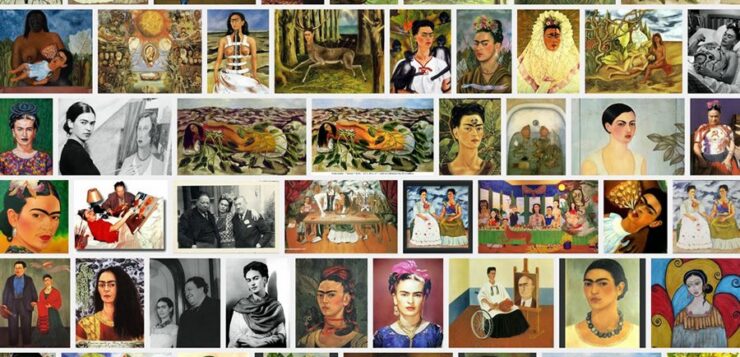“I paint myself because I am often alone and I am the subject I know best.” Frida Kahlo
Frida Kahlo was a brilliant painter, but a far more exceptional woman. Her recognition today is far wider, her contribution and merit much better appreciated. But even during her lifetime she was far ahead of contemporary mould and mindset. She was, first demurely and later boldly, more than willing to break the cast and establish a uniquely extraordinary identity. And she did so with style, statement and panache!
What does pain do to humans?
Much. And more intense, more excruciating, more soul-searing the pain, greater is its impact on the human mind. Those who had a close brush with death or who had a near-death experience, once recovered, either completely overcome and win over the fear of death or they become so obsessed with the pain and prospect of death that they continue to die every moment of the remainder of their existence. This encounter, infrequent but not rare, immanently ingrained both in physiology and psychology of the person, gets permanently, indelibly engraved and etched on one’s psychic slate that alters one’s purpose of existence immutably.
Frida belonged to the former experience. Once she recovered, though she continued to physically suffer in some way or the other, she not only overcame the fear or imminence of death, she, indeed, but also became defiant and ridiculed death. This, in some way, explains her preference of themes of pain and suffering; and her derision of the same in most of her creations – vibrant in colour, deeply drenched in sad sublime pathos, aglow with luminosity, douce but disturbing at the same time. She immortalized her personal experience of chronic pain in her paintings, defining even celebrating her spirited triumph over the inflictions of fate.
Early Life
Born Magdalena Carmen Frida Kahlo y Calderón to a German father and a mestiza mother, Kahlo spent most of her childhood and adult life at La Casa Azul, her family home in Coyoacán (today it houses the famous and popular Frida Kahlo Museum). She was disabled by polio as a child but proved herself to be promising enough to qualify for medical school until she suffered a bus accident at the age of 18, which caused her lifelong pain and medical problems. During her recovery, she returned to her childhood interest in art with the idea of becoming an artist.
Body of Work
There are three aspects of Frida’s oeuvre that stand out. The most evident aspect is of course the underlying pain her body and soul had received early in life and which endured as an abiding aspect of her physical existence, the best expression of which gets imminently expressed in her portraits, the majority of them being her own. The second aspect is her passionate attachment to the popular culture of Mexico and of artefacts, folk art, even natural bounties of her homeland mirrored majestically in her portrayals. This aspect is so pronounced in her paintings that they are treated by many as emblematic of Mexican national tradition and culture. The third and the most striking aspect, however, remains the depiction of feminine experience and form fearlessly and boldly, stated without compromise or reservation. The first aspect dominated her initial years of creativity, while she was still unexposed to the influences obtaining in the world outside Mexico. The second aspect dominated her work after her paintings were seen and noticed in the US and France. The third aspect of a feminine perspective underlined almost all her works, at times boldly and eloquently; and at others, subtly and subliminally, even mutely. Kahlo’s unique identity as a painter makes her stand out largely owing to this permeated, suffused and yet brightly emitting scintillas of feminine sensibilities.
In a Man’s world
Painting for Kahlo was always an exploration of questions and conundrums of identity and existence. The accident and the isolating recovery period made her desire “to begin again, painting things just as [she]saw them with [her]own eyes and nothing more.” Her corporal pain and disability and the attendant loneliness blended so beautifully with her creativity that the outcome was effortlessly brilliant, eloquent and touching.
Her passionate love affair with Diego Rivera culminating in her marriage with him transformed her in extraordinary ways. Content to be always introduced as Diego’s wife, her own identity as a painter became evident when she toured US with Diego. Diego was already a mural painter of considerable standing by then. She preferred to remain in his shadows even when she had begun producing paintings in her own distinct style. When they were in Detroit together, none of Kahlo’s work was featured in exhibitions in Detroit, though she did give an interview to the Detroit News on her art. The article that appeared, however, was condescendingly titled “Wife of the Master Mural Painter Gleefully Dabbles in Works of Art”.
Even much later, when she had already held more than half a dozen exhibitions, in November 1938, reviewing her exhibition in New York, Time wrote “Little Frida’s pictures … had the daintiness of miniatures, the vivid reds, and yellows of Mexican tradition and the playfully bloody fancy of an unsentimental child”. Not very flattering, and typically patronising to a woman artist.
While Diego did encourage and mould her creativity and introduced her to his circle of friends and fellow artists, her own sensitivity and restlessness began to bloom, first during her sojourn to the US with Diego and then with the encouragement and support of Andre Breton, the founder of ‘surrealism’, to France. Breton, saw in her, the very essence of surrealism, where the dream and reality indistinguishably mingle and merge. Her exhibitions in San Francisco and Boston in US; and in Paris in France brought her recognition but more than that she began to discover her own independent identity giving her the courage and boldness to experiment with newer techniques of paintings focusing on themes that appealed and touched her sensitivities. She wanted her exhibition in France to be a success, which it was not. Yet, Louvre bought one of her paintings ‘The Frame’, the first one from a Mexican artist to be included in their collection. In her 40s and subsequently, till her death she confined herself to exhibitions in Mexico and US and to teaching. She taught at the Escuela Nacional de Pintura, Escultura y Grabado (“La Esmeralda“) and was a founding member of the Seminario de Cultura Mexicana. Her solo exhibition in 1953 preceded her death in 1954.
A woman of passion
If the marriage with Diego was a delicious denouement in her physically painful life, the divorce and reconciliation with him after one year, contributed to diversifying her portrayals of the colours and contours of life and took her expressions of sensitivity to as yet unknown and unexplored levels. It did not help matters that Diego’s wandering affections and numerous liaisons also embraced her own younger sister. The paintings made by her during this period of separation which was intensely distressing, deranging and destabilizing depict a range of emotions-helplessness, revenge, rage, and surrender against a person she could not live without. No painter had ever portrayed so effectively and poignantly and passionately, the power and hold of affection and dependence of a woman for and to a man. To draw self-images on such a volatile theme was by any standard intrepid defiance of the prevailing conventional position of women in society in Mexico then, in an unprecedented assertion both courageous and unprecedented.
In keeping with the times then, Frida was also attracted to the ideas of socialism; gender, class and race- equality and empathized with the resentment and rebellion against discrimination and injustice and exploitation of poor and underprivileged. These were the times when to do so was not only passionately popular but also deemed fashionable, even romantic. Given the highly emotional nature of Frida, her fascination and attraction to men with strong conviction and commitment to these ideologies were distinctly pronounced. This partly explains her love and fascination for and attachment to her fellow artist and painter Diego Rivera, who was not only older but could offer an intellectual fulfilment Frida had always craved.
Surreal or Traditional?
She experimented with different techniques, such as etching and frescos. Despite the popularity of the mural in Mexican art at the time, she adopted a diametrically opposed medium, votive images or retablos– religious paintings made on small metal sheets by amateur artists to thank saints for their blessings during a calamity. Amongst the works she made in the retablo manner in Detroit are Henry Ford Hospital (1932), My Birth (1932), and Self-Portrait on the Border of Mexico and the United States (1932). Kahlo had an extensive collection of approximately 2,000 retablos, establishing Kahlo’s interest and prowess to use narrative and allegory to the limits of iconic purity.
Trees, Roots, Thorns, Hair, Eyebrows, Anatomy were some of the icons that she liberally used, as also the Aztec symbols drawn from its mythology. While her visual portrayals were bold and vivid, the underlying meanings and messages were always subtle and often ambiguous, as if revealing the conflict in her mind. Her paintings were also invariably an exercise of reconciliation between opposites. So, while there was death, there was also life side by side, if there was hope, there was despair as well, and if there was decay and destruction, there was regeneration and growth too. That surrealists like Breton and the Mexican traditionalists were simultaneously able to see powerful though conflicting messages in her paintings only illumine her genius.
While she did enjoy moments of recognition and fulfilment during her lifetime, her work was reassessed by the late 1970s by art historians and political activists. By the early 1990s, she had become not only a recognized figure in art history but also regarded as an icon for Chicanos, the feminism movement- a social and political movement, inspired by prior acts of resistance among people of Mexican descent. The defining aspect of her work and the most important facet of her art, however, eminently reveals her identification with La Raza, the people of Mexico, and her profound interest in its culture.
Variously described by art critics as ‘Symbolist’, a Folk Artiste, practising elements of ‘Magical Realism or New Objectivity’ and drawing elements of fantasy, naivety, and fascination with violence and death, Kahlo’s work today stands celebrated internationally as emblematic of Mexican national and indigenous traditions and by feminists for what is seen as its undaunted and uncompromising depiction of the female experience and form. But in essence, her style developed mixed reality with surrealistic elements, often depicting pain and death. It’s a style that evolved with the spontaneity of elemental energy spurred by the diverse experiences of her life. Her oeuvre is a distillation of a synthesised amalgam of prevailing artistic traditions, indigenous movements, peer influences and above all a personal life replete with pain and an indomitable spirit of its defiance.
A feminist
Kahlo, thus, created in herself a unique and unusual woman of Art who was at once feminine, Mexican, modern, and powerful and who dared to diverge from the usual dichotomy of roles of mother/other woman allowed to females in contemporary Mexican society.
Women have often been neglected as major contributors to the history of the world either through commission or distortion. It’s a delight for us to have taken on the challenge to unearth these overlooked gems and keep relevant the stories of amazing women in history.
The author was the former Information and Broadcasting Secretary, GOI. Mr Uday Kumar Varma, serves as an esteemed jury member on the SABERA The Social and Business Enterprise Responsible Awards 2021 Jury Board.
This article is the third in the series of women in history who have excelled in their area of passion. The first being on activist Emmeline Pankhurst from England and the second on the lady sniper Lyudmila Pavlichenko





